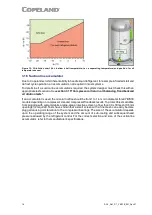
AGL_Ref_ST_YBK1E_EN_Rev01
29
may occur when a scroll compressor is started in a vacuum causing burnout of the internal lead
connections.
6.5.3 Compressor return procedure
Compressors from systems with A1 refrigerant can be sent back to Emerson for diagnosis with closed
connections and the oil f illing inside. However, the ref rigerant should be removed f irst. In addition,
the warning sticker with the flammable symbol should be removed so that the compressors are not
misdeclared on receipt at the factory.
For all systems with A2L ref rigerants, if a compressor has to be returned to the manuf acturer for
analysis, the ref rigerant and the oil have to be removed completely. For the shipping process, all
compressor connections must remain open and warning stickers f or flammable refrigerant must be
placed on the shipping box.
▪
During the entire working procedure continuously check if the ambient atmosphere is flammable.
If a f lammable atmosphere is detected, ensure proper ventilation of the working space and
immediately cut-off the power supply.
▪
Resume working after the atmosphere is no longer dangerous.
▪
Recover the ref rigerant f rom the system using a suitable recovery unit. During this action, the
compressor crankcase heater could be energized
– immediately de-energize in case a flammable
atmosphere is detected.
▪
Recover to 3 mbar absolute pressure or lower. For best results and to recover also the refrigerant
dissolved in the oil, run the recovery unit two or three times as necessary.
▪
Flush the whole system with oxygen-free dry nitrogen.
▪
Open the system with a cutting tool and purge the entire system with dry nitrogen.
▪
Disassemble the compressor with a cutting tool. Drain and recover compressor oil properly. Flush
the compressor with dry nitrogen again for a f ew minutes.
▪
The compressor should be returned f ree of oil and with connections open
– do not close
connections with plugs.
▪
Collect and secure the oil properly. Provide information about the quantity of oil drained from the
compressor and its colour. Ideally, send a good picture.
▪
Dispose of the oil according to local rules and regulations.
▪
Use a proper cardboard box package when preparing the compressor f or shipment. Place
warning icons
on each side and on the top of the box. Mention the following message on
the box:
"Warning! Flammable A2L refrigerant compressor for analysis"
.
▪
The compressor must be kept in the upright position
– mark the box accordingly.
▪
If more than one compressor have to be returned, each compressor must be packed individually.
NOTE: Check with the transport company that all the requirements that apply to such
shipments are complied with.
6.6
Lubrication and oil removal
WARNING
Air/A2L flammable refrigerant mixture! Flammable atmosphere! Fire
hazard!
When removing oil f rom an A2L ref rigerant system, use suitable
recovery unit and recycling bottles also for oil disposal as A2L refrigerant may
still be dissolved in the oil.
CAUTION
Chemical reaction! Compressor destruction!
Do not mix up ester oils with
mineral oil and/or alkyl benzene when used with chlorine-f ree (HFC)
ref rigerants.
The compressor is supplied with an initial oil charge. The standard oil f or use with YB*K1E
compressors is a polyolester (POE) lubricant Emkarate RL32 3MAF. See nameplate for original oil
charge shown in litres. A field recharge is from 0.05 to 0.1 litre less.
One disadvantage of POE is that it is f ar more hygroscopic than mineral oil
– see
Figure 18
. Only
brief exposure to ambient air is needed f or POE to absorb sufficient moisture to make it unacceptable



















